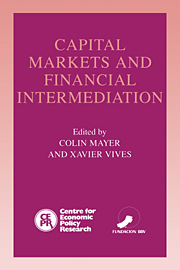Book contents
- Frontmatter
- Contents
- List of figures
- List of tables
- Preface
- List of conference participants
- 1 Introduction
- 2 Efficient governance structure: implications for banking regulation
- Discussion
- 3 Bank loan maturity and priority when borrowers can refinance
- Discussion
- 4 Stock markets and resource allocation
- Discussion
- 5 Informational capacity and financial collapse
- Discussion
- 6 Financial intermediation and economic development
- Discussion
- 7 Creditor passivity and bankruptcy: implications for economic reform
- Discussion
- 8 Enterprise debt and economic transformation: financial restructuring in Central and Eastern Europe
- Discussion
- 9 Bank regulation, reputation and rents: theory and policy implications
- Discussion
- 10 Relationship banking, deposit insurance and bank portfolio choice
- Discussion
- 11 Competition and bank performance: a theoretical perspective
- Discussion
- Index
Discussion
Published online by Cambridge University Press: 04 August 2010
- Frontmatter
- Contents
- List of figures
- List of tables
- Preface
- List of conference participants
- 1 Introduction
- 2 Efficient governance structure: implications for banking regulation
- Discussion
- 3 Bank loan maturity and priority when borrowers can refinance
- Discussion
- 4 Stock markets and resource allocation
- Discussion
- 5 Informational capacity and financial collapse
- Discussion
- 6 Financial intermediation and economic development
- Discussion
- 7 Creditor passivity and bankruptcy: implications for economic reform
- Discussion
- 8 Enterprise debt and economic transformation: financial restructuring in Central and Eastern Europe
- Discussion
- 9 Bank regulation, reputation and rents: theory and policy implications
- Discussion
- 10 Relationship banking, deposit insurance and bank portfolio choice
- Discussion
- 11 Competition and bank performance: a theoretical perspective
- Discussion
- Index
Summary
In an earlier paper, Dewatripont and Tirole (1992), the authors have developed a model to explain why it is efficient for creditors to take control of a firm when it experiences difficulties and why shareholders should retain control of the firm in good times. In this model there is a verifiable signal of the firm's financial position and creditors take control of the firm when this signal indicates that profits will be low. When the verifiable signal indicates high profits, the firm is left under the control of shareholders. The model uses the well-known facts that the creditors' welfare is a concave function of the firm's profit and the shareholders' welfare is a convex function of the firm's profit. The part in control of the firm, then, uses a non-verifiable, i.e. non-contractible, signal as the basis for deciding whether or not to allow the firm's manager to remain in control of the firm. When a manager is in control of the firm, the firm's profit distribution is more ‘risky’ (in the sense of second-order stochastic dominance) than when they are not in control. For this reason, the risk-averse creditors will replace the manager more often than the riskpreferring shareholders. This is the efficient regime when the verifiable and unverifiable signals are both positively correlated with high profits as assumed. In their paper on bank regulation, Dewatripont and Tirole apply this model of debt to a bank. In this application, the bank's creditors are its depositors. It is argued that, because the depositors are each small creditors and are, therefore, unable to act concertedly to assume control when it is efficient to do so, regulators should act on their behalf.
- Type
- Chapter
- Information
- Capital Markets and Financial Intermediation , pp. 36 - 45Publisher: Cambridge University PressPrint publication year: 1993



